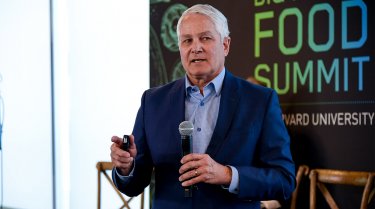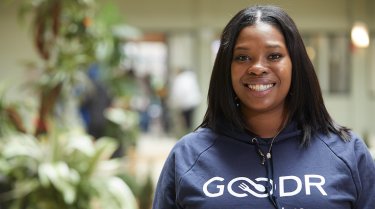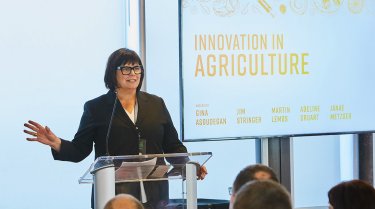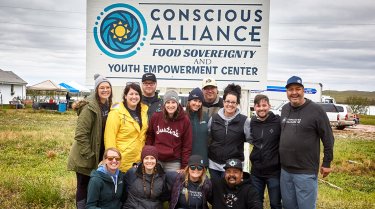All of us eat to live, and some of us arguably live to eat. But far fewer of us help everyone eat healthier, more readily, more sustainably. The latter are the rare entities whose work revolves around making our food landscape better in so many ways.
Meet some of the leaders who are shaping our food world. We salute them for their vision, their determination and their hunger to feed all of us — mind, body and soul.
Farm Foundation Joe Swedberg

In his position as chairman and now, immediate past chairman, of Farm Foundation, Joe Swedberg is involved in something he believes can truly make a difference: antimicrobial resistance.
The 87-year-old foundation, described by Swedberg as a “no-partisan, nonlobbying convener for food and agricultural issues,” has partnered with the Pew Charitable Trusts for the purpose of convening a broad group of organizations and companies interested in developing a sustainability definition and framework for the use of antibiotics in animal agriculture. What makes the initiative unique, Swedberg said, is the diverse group of people sitting around the table.
“We have many of the major players,” he said.
Members of the task force represent producer groups, processors, retailers, foodservice operators and pharmaceutical companies, among others.
“In today’s environment, our coalition is a prime example of what can get done when people actually sit down at the table together and concentrate on the things they can agree upon rather than their differences.”
The group set about the task of creating a definition for antibiotics stewardship in livestock and developing the core components of a sustainable program. According to Swedberg, the issue has wide-reaching implications for the food and agricultural industry, in addition to human health.
“We’re all interested in being able to responsibly use antibiotics when needed for people and animals, as well as preserve them for future generations,” he said, adding that Farm Foundation and PEW have kept the U.S. Food and Drug Administration and the U.S. Department of Agriculture “in the loop.”
In fact, the FDA and the USDA gave Farm Foundation their blessing during the discovery phase of the project.
In 2015, Farm Foundation approached the FDA, offering to assist in reaching out to producers, veterinarians and feed producers on their roles in implementing new guidelines and regulations relating to the use of medically important antibiotics used as growth promotants. That was the starting point for the work of the task force.
Hormel Foods was among the first companies to embrace the effort, joining Farm Foundation at the initial meeting with the FDA to make the announcement.
For his part, Swedberg built a 34-year career with Hormel Foods, rising to the level of vice president of legislative and regulatory affairs. His time with the company and his background as the son of an Iowa farmer have prepared him well for his current role.
“Growing up in food and agriculture, and being exposed to sales, marketing and then the legislative/regulatory aspects have exposed me to a broad scope of our business,” he said.
“Plus, I was located in Austin, Minn. I knew the issues. I lived them.”
Though he retired from the corporate world in 2015, Swedberg is anything but retired. His passion now is to help bring forth a set of best practices for antibiotics use.
“My dream, my hope is that someday when you look at the website of anyone involved in the food and agriculture sector, there will be a similar antibiotic stewardship and practice message, based on the work we are now doing.”
GoodrCo. Jasmine Crowe

Jasmine Crowe won’t soon forget the first time hunger was too close for comfort – or perhaps better put – complacency. Her college roommate had just moved from New York City to Atlanta, and the two women were catching up. Savannah opened her fridge to get a glass of water for Crowe, and that’s when she “saw the light,” literally and metaphorically speaking.
“There was a bright light shining in my eyes from the [mostly empty] refrigerator. This was the day hunger became deeply personal to me,” she said. “Savannah had fallen on hard times, and I had no idea.”
Young, bright, educated and socially conscious, Crowe is giving food insecurity a one-two punch with her organization, GoodrCo. What sets her initiative apart is her use of blockchain technology via an app that connects the dots between businesses that have food and organizations that need it.
“If we can use technology to meet our future husband or wife, we can use it to fight hunger,” she said.
Even before Crowe reunited with her college friend, she was well aware of the prevalence of food insecurity in her country; the widespread problem CNBC once dubbed “America’s dirty little secret.” In fact, she had already launched Sunday Soul, a weekly family meal of sorts for Atlanta homeless people. Not only did Crowe do the cooking, she saw to it that music, dancing and eventually linens and flowers were part of the bargain as Sunday Soul grew and expanded to other major U.S. cities.
However, Savannah’s plight showed her hunger isn’t merely a street issue, and that made her more determined than ever to throw down the gloves and brace herself for the fight of her life.
For the record, her opponent is a formidable one. According to Feeding America, nearly one in seven Americans goes to bed each night on an empty stomach. More than 42 million people – half of whom are children or seniors – suffer from hunger in what Crowe described as “the richest country in the world.”
As she put an increasing amount of brain power toward the task of eradicating hunger, she came to realize it wasn’t a question of too little food to go around. For starters, her restaurant work during school showed her how much serviceable product was going directly to landfills instead of to food banks and shelters. More than that, statistics from well-regarded groups such as the U.S. Department of Agriculture, and the Food and Agriculture Organization of the United Nations backed her up. Somewhere around 40 percent of food is wasted, a phenomenon that has social, economic and environmental implications, Crowe asserted.
“Hunger is a logistics issue,” she said. “We have to first eliminate the access barrier that keeps people from obtaining food.”
Goodr uses an app to get food that would otherwise be wasted to people and organizations that use it to feed the hungry. Transportation barriers are eliminated. As a bonus, the app allows businesses to track and account for their donations.
Crowe charges businesses as any waste-management service would, but there is no cost to the receiving parties. In addition, tax write-offs are available to those donating, as is federal protection from liability. Even better, everybody gets to eat.
“This food that is going to waste is so much more than waste,” she said. “It is power, it is change, it is treasure.”
“We decided to launch the business to prove one can build ecologically friendly enterprises that are also financially successful,” Hirshberg said. “There was very little organic anything in the marketplace. It was a completely foreign concept.”
Capitalizing on a yogurt recipe developed by Kaymen, the men started turning Stonyfield into an honest-to-goodness commercial food business. They were living on a farm, growing organic food and trying in general to be as self-sufficient as possible. All of the ingredients – short of vanilla – were local; the milk for their yogurt came from Kaymen’s personal herd of cows.
The first nine years of Stonyfield’s history were lean ones. But turning a profit was far from the only motivation.
“We started as educators, so we wanted to teach our customers about healthy eating and the environment and about why food choices matter,” Hirshberg said. Years later, theirs was the first organic company to sell its products to Walmart, something they wanted to do, “Because that’s where America shops, and because organic foods should be accessible to everyone, not just the elite.”
These days, the company has revenue in the range of $400 million and generates market rates of return. If that weren’t enough, Hirshberg has the title of his dreams: chief organic optimist. When he speaks to up-and-comers – and he works with and invests in a lot of them through the Hirshberg Entrepreneurial Institute – he likes to describe his venture with Kaymen as a “35-year overnight success.” Indeed, in addition to having a compelling and credible story to tell, he has a gift for weaving the tale into an entertaining one.
Hirshberg also brings his expertise and vision to the advisory board of Applegate Farms, part of Hormel Foods. He’s no stranger to the company; Applegate was founded by one of Hirshberg’s college friends. Like Stonyfield, Applegate is demonstrating that organic brands can thrive at the national level. That gives him hope and the desire to persevere, he said.
“I’m proud that the organic sector is close to $60 billion in annual revenue, but it still only represents 6 percent of U.S. food. There is so much more that can be done,” he noted.
One of the obstacles to accessibility is cost. Organic food typically commands a higher price, which discourages many consumers from going in that direction.
“The goal is to get to bigger scale without penalizing farmers,” he said. “We can bring down the price differential between organic and nonorganic food. With more demand, the price would go down further.”
“Buy as much organic food as you can, beginning with fruit and vegetables, then animal products,” he advised. He believes consumer demand is key to supporting preventive health care and ecological benefits such as soil carbon building, reduced toxicity and biodiversity, not to mention financial stability for producers.
“Stonyfield’s nearly 2,000 family farmers make far more money than when they were farming conventionally. Organic delivers higher growth to food companies and retailers,” he said.
“Organic is a win-win-win proposition for all of us and for future generations. Who doesn’t support that?”
Last year, Applegate brought to market THE NEW FOOD COLLECTIVE™, a premium brand that uses pasture-raised meats and small-batch production methods to create culinary-inspired products. The launch features a line of fresh sausages that comes from regenerative agricultural systems. Not only is Asoudegan helping to change the way meat is raised, she’s demonstrating it can be good for the planet.
At the same time, she’s meeting head on any skeptic who raises an eyebrow when it comes to sausage ingredients. “You’re going to want to see how this sausage is made,” makers of THE NEW FOOD COLLECTIVE™ are proclaiming.
“I like the idea of radical transparency,” Asoudegan said. “I’m proud of the way our animals are raised, and how our products are made.”
Conscious Alliance has developed relationships with other nonprofit organizations, transportation companies and members of the food industry. The latter, in particular, give Conscious Alliance an additional steady stream of high-quality food to distribute to those in need.
“Brands can’t sell products to stores if the best-by date is within 90 days,” he said. “We have a system in place to get the food and distribute it before it expires directly into the hands of kids and families who need it most by partnering with schools and food banks in remote areas in the United States.”
At times that means working with other nonprofit groups with similar goals. According to Levy, there is no place for territorialism when it comes to feeding people.
“Within this world of hunger relief … it’s not a competition. We’re actually all on the same team, rowing in the same direction.”


